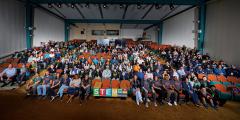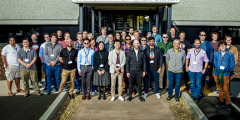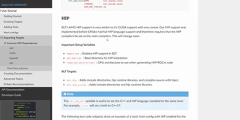LLNL Computing’s ground-breaking research and development activities, innovative technologies, and world-class staff are often featured in various media outlets.

Source: insideHPC
Kathryn Mohror: a passion for managing scientific data
This interview with HPC-AI Vanguard Kathryn Mohror covers her thoughts on teamwork, her projects, the field, and more.
AI/ML Careers Data Science HPC Systems and Software Storage, File Systems, and I/O

Source: LLNL News
Second ‘STEM Day at the Lab’ in 2024 ignites student engagement
LLNL welcomed more than 240 students and chaperones from the Central Valley to the second ‘STEM Day at the Lab’ in 2024. STEM Day is a biannual daylong interactive event for students (grades 5-8) from underserved communities.

Source: LLNL Computing
Girls Who Code ‘Altamont Connection’ brings Livermore and Tracy students to the Lab for the second year
High school students from Livermore and Tracy recently visited LLNL bringing participants from the two cities’ Girls Who Code programs together on-site for group activities and tours.

Source: LLNL News
A look back at SC24
SC24, held recently in Atlanta, was a landmark event, setting new records and demonstrating LLNL's unparalleled contributions to HPC innovation and impact.
AI/ML Awards Collaborations Data Science Emerging Architectures Events Exascale HPC Architectures HPC Systems and Software Scientific ML

Source: LLNL News
Data Days workshop gathers DOE national labs to discuss future of data management
Drawing more than 300 attendees, this year’s “D3” workshop focused on tackling pressing data challenges in nuclear security, energy and collaborative scientific discovery, and featured a host of talks, presentations and panels.
Collaborations Data Management Data Science Data-Driven Decisions Events ML Theory

Source: Science & Technology Review
S&TR cover story: GUIDEing drug development
The Generative Unconstrained Intelligent Drug Engineering (GUIDE) program accelerates development of medical countermeasure candidates to redefine biological defense.
AI/ML Biology/Biomedicine Computational Science Data Science Natural Language Processing Scientific ML

Source: LLNL News
LLNL teams win two HPCwire awards at SC24
Two teams led by LLNL computer scientists won Editor’s Awards from HPCwire, a leading high performance computing industry publication, at the 2024 Supercomputing Conference in Atlanta.
Awards Emerging Architectures HPC Architectures HPC Systems and Software Open-Source Software Software Build and Installation

Source: LLNL Computing
Workshop highlights new research using finite element methods
Held for the first time in a hybrid format, the multi-day MFEM workshop drew participants from around the globe.
Computational Math Computational Science Discrete Mathematics Events HPC Systems and Software Open-Source Software PDE Methods Programming Languages and Models Software Libraries Transport

Source: LLNL News
NNSA researchers break the molecular-dynamics timescale barrier with world’s largest chip
In a groundbreaking development for computational science, a team of Tri-Lab researchers has unveiled a revolutionary approach to molecular dynamics simulations using the Cerebras Wafer-Scale Engine, the world’s largest computer chip.
Computational Science HPC Architectures HPC Systems and Software Materials and Manufacturing

Source: LLNL News
Podcast: Introducing El Capitan
On the newest episode of the Big Ideas Lab podcast, listeners will go behind the scenes of LLNL's latest groundbreaking achievement: El Capitan, the world’s most powerful supercomputer.
Emerging Architectures Exascale HPC Architectures HPC Systems and Software Hybrid/Heterogeneous Multimedia

Source: GlobeNewswire
LLNL and Oxide work together to advance cloud and HPC convergence
Oxide Cloud Computer installation at Livermore Computing's HPC center modernizes on-premises cloud computing capabilities for general purpose workloads.
Collaborations Emerging Architectures HPC Systems and Software Scientific Cloud Computing

Source: LLNL News
El Capitan verified as world's fastest supercomputer
Verified at 1.742 exaflops (1.742 quintillion calculations per second) on the High Performance Linpack—the standard benchmark used by the Top500 organization to evaluate supercomputing performance—El Capitan is the fastest computing system ever benchmarked.
Emerging Architectures Exascale HPC Architectures HPC Systems and Software Hybrid/Heterogeneous

Source: LLNL Computing
Road to El Capitan 11: Industry investment
The NNSA’s exascale milestone is possible only through successful industry partnerships. Hewlett Packard Enterprise staff share their experiences working with LLNL.
Co-Design Collaborations Exascale HPC Architectures HPC Systems and Software Hybrid/Heterogeneous

Source: LLNL News
Podcast: Impact and legacy of DYNA3D
An iconic LLNL computer code that has saved the automobile industry billions of dollars is the focus for the newest episode of the Big Ideas Lab Podcast.

Source: R&D World
Magazine showcases R&D 100 Award winners
The latest issue of R&D World's magazine showcases LLNL's 2024 winning technologies, including UnifyFS and UMap software projects.
Data Movement and Memory Emerging Architectures HPC Systems and Software Near Memory Computing Open-Source Software Storage, File Systems, and I/O

Source: LLNL Computing
SC24 event calendar
LLNL is participating in the 36th annual Supercomputing Conference (SC24) in Atlanta on November 17–22, 2024.
AI/ML Awards Computational Math Computational Science Data Science Community Emerging Architectures Events Exascale HPC Architectures HPC Systems and Software Hybrid/Heterogeneous Open-Source Software Outreach Performance, Portability, and Productivity Programming Languages and Models Scientific ML Software Build and Installation

Source: Science & Technology Review
Revolutionizing quantum science
Livermore’s advances in quantum science research present new paradigms for computing, direct simulation, studying complex quantum phenomena, and unprecedented precision in sensing.

Source: LLNL Computing
Simulating liver surgeries with virtual reality
A virtual reality training platform allows liver surgeons to prepare and train outside of the operating room.

Source: LLNL News
Breaking the ICE: ICECap looks to use exascale fusion simulations to pioneer digital design
A groundbreaking multidisciplinary team is combining the power of exascale computing with AI, advanced workflows, and GPU acceleration to advance scientific innovation and revolutionize digital design.
AI/ML Computational Science Data Science Emerging Architectures Exascale HPC Architectures HPC Systems and Software Lasers and Optics Scientific ML

Source: Hewlett Packard Enterprise
Video: Update on the El Capitan supercomputer
Learn about the game-changing potential of El Capitan and discover how it will not only transform HPC and AI but also revolutionize scientific research across multiple domains.
AI/ML Computational Science Data Science Emerging Architectures Exascale HPC Systems and Software Multimedia Scientific ML

Source: High Performance Computing Innovation Center
Video: HPC tutorials playlist updated for 2024
Follow along at your own pace through tutorials of several open-source HPC software projects.
Computational Math Computational Science HPC Systems and Software Multimedia Open-Source Software

Source: LLNL News
HPC4Mfg workshop gathers innovators for collaborative discussions
The event attracted more than 60 attendees from diverse sectors and featured discussions aimed at fostering new collaborations with various DOE offices and national labs.
Computational Science Emerging Architectures Events HPC Systems and Software Materials and Manufacturing Outreach

Source: LLNL News
Podcast: History of LLNL supercomputing
Listen to the latest Big Ideas Lab podcast episode on LLNL supercomputing! This article contains links to the podcast on Spotify and Apple.
Emerging Architectures Exascale HPC Architectures HPC Systems and Software Hybrid/Heterogeneous Multimedia

Source: LLNL News
DOE honors seven early-career Lab scientists
Among them is Shusen Liu, a computer scientist in the Machine Intelligence Group in the Center for Applied Scientific Computing.

Source: LLNL News
LLNL’s Mohror honored with prestigious technical computing award
The Association for Computing Machinery's (ACM) Special Interest Group on High Performance Computing (SIGHPC) has awarded Kathryn Mohror with its prestigious Emerging Woman Leader in Technical Computing (EWLTC) Award.
Awards Exascale Fault Tolerance and Resilience HPC Systems and Software Performance, Portability, and Productivity Storage, File Systems, and I/O

